JEHOVAH’S WITNESSES TIMELINE
1852 (February 16): Charles Taze Russell was born in Allegheny, Pennsylvania.
1869 (November 8): Joseph Franklin Rutherford was born in Versailles, Missouri.
1872: Russell founded the International Bible Students Association in Pittsburgh, Pennsylvania.
1874: The year designated by Russell for Christ’s invisible return.
1880s: Russell organized the first Bible Society Association meetings.
1884: Zion’s Watchtower Tract Society was incorporated.
1914: The year Russell expected Christ’s visible second coming.
1916 (October 31): Russell passed away.
1919: Joseph Franklin Rutherford succeeded Russell as president of the society and adopted the slogan, “Millions Now Living Will Never Die!”
1939: (November 1) Rutherford published an article in The Watchtower on “neutrality,” advising members to avoid involvement in political affairs.
1995 (November 1): The monthly issue of The Watchtower adjusted apocalyptic expectations by redefining the “last generation” more inclusively.
FOUNDER/GROUP HISTORY
Charles Taze Russell was the second of five children born to Joseph Lytel Russell and Ann Eliza Birney in Allegheny, Pennsylvania in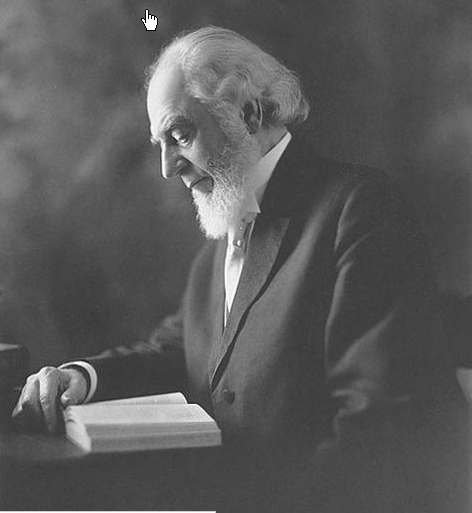 1852. The Russells were a Presbyterian, middle-class family of cloth merchants. Russell inherited the family business, and under his leadership, it became extremely successful. He subsequently sold the six retail stores at great profit in order to fund his publishing and preaching activities. As a young man, he had briefly drifted away from Calvinist Presbyterianism, in favor of the Arminian influenced Methodist Episcopalian church. For a time he lost his faith completely and then briefly explored a number of Asian religions, including Buddhism, Confucianism, Hinduism, and Taoism. After these youthful explorations, however, he was formatively influenced by the Millerites, or Adventists, as they came to be known. Beginning in 1831, William Miller, a Baptist preacher, had acquired many followers with his scripturally based predictions that Christ would return to Earth in 1844 and the apocalypse would then follow. When 1844 passed uneventfully, which is termed the “Great Disappointment,” many followers left, although the movement survived. Some Adventists recalculated the date of the impending apocalypse as occurring in 1874 or 1875.
1852. The Russells were a Presbyterian, middle-class family of cloth merchants. Russell inherited the family business, and under his leadership, it became extremely successful. He subsequently sold the six retail stores at great profit in order to fund his publishing and preaching activities. As a young man, he had briefly drifted away from Calvinist Presbyterianism, in favor of the Arminian influenced Methodist Episcopalian church. For a time he lost his faith completely and then briefly explored a number of Asian religions, including Buddhism, Confucianism, Hinduism, and Taoism. After these youthful explorations, however, he was formatively influenced by the Millerites, or Adventists, as they came to be known. Beginning in 1831, William Miller, a Baptist preacher, had acquired many followers with his scripturally based predictions that Christ would return to Earth in 1844 and the apocalypse would then follow. When 1844 passed uneventfully, which is termed the “Great Disappointment,” many followers left, although the movement survived. Some Adventists recalculated the date of the impending apocalypse as occurring in 1874 or 1875.
In 1870, Russell attended a speech by Adventist preacher Jonas Wendell, who impressed Russell with his biblical knowledge and prediction that Christ would return in 1873 or 1874. Russell formed close friendships with other Adventist preachers, George Storrs and George Stetson, who, like Russell himself, engaged in an intense study and analysis of the Bible. In 1872, Russell launched the Bible Study movement when he organized the first meeting of the International Bible Students Association in Pittsburgh, PA. The Bible Study movement quickly spread to other cities and towns, and gathered hundreds of followers.
A major development in Russell’s faith occurred in 1876 when he encountered the writings of Nelson Barbour, Barbour, an Adventist, claimed that the Milleniumium had begun, and that Christ was already living invisibly on earth. Earlier that year, Russell’s Bible Study group had reached the same conclusion. Russell soon arranged a meeting with Barbour whose biblical chronology convinced Russell that the Rapture would take place in 1878, to be followed by an apocalypse that would restore the faithful to kingship with Christ on earth and destroy the unfaithful. Russell immediately sold his business interests, which yielded a substantial fortune, in order to finance his religious activities. He financed, and became a co-author on, Barbour’s book, Three Worlds and the Harvest of This World (1877).
Barbour and Russell then began preaching and publishing together. (Barbour and Russell, 1877) Their partnership lasted several years, but, when the expected 1878 date passed without incident, Russell broke with Barbour theologically and withdrew his financial backing. In 1879, Russell founded his own periodical, Zion’s Watch Tower and Herald of Christ’s Presence, which eventually became the major Jehovah’s Witness publication, The Watch Tower. Barbour went on to found his own congregation, The Church of the Strangers.
Following the uneventful passing of the 1878 date, Russell launched himself into an ever recurring process of revision. (Bowman 1995; Penton 1985) At first he said that Christ’s presence was invisibly felt on earth; the souls of the “anointed” humanity would immediately rise to heaven upon their deaths. Later, he “recalculated” the date of the rapture, setting it for 1914. Although once again, the rapture did not materialize, the advent of World War I, lent some credibility to Russell’s prediction. Throughout the rest of his life, Russell predicted and revised, found new associates with whom to publish, and broke with these associates as the predictions failed. This pattern of short-term associations carried over into his marriage. His wife and fellow editor, Mary Frances Russell, whom he had married in 1880, left him in 1889, claiming that he refused to share editorial responsibility with her. She subsequently divorced him in 1904.
While Russell’s numerous predictions of Christ’s return were not confirmed by visible, earthly events, Russell did launch the widely successful Bible Study movement. He organized the first Bible Study Association in Pittsburgh, PA in 1872. Nine years later he founded the Zion’s Watch Tower Tract Society. Russell subsequently wrote and published extensively about biblical interpretation, with his accumulated writings tallying about 50,000 pages. It is estimated that his six volume tome, entitled Studies in the Scriptures (originally titled Millennial Dawn), was read by twenty million people. The tall and magnetic preacher, with flowing beard and handsome face, attracted large crowds as he lectured extensively throughout first the United States, and in England.
After Russell’s death in 1916, although there were many schisms among the Bible Study groups and publishing houses, one Bible 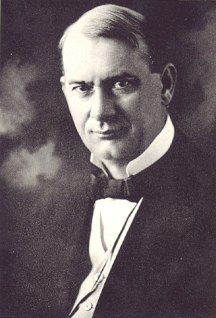 Study group dominated. Under the leadership of Joseph Franklin Rutherford, it was incorporated as the Watchtower Bible and Tract Society, the Jehovah’s Witness organization, with Rutherford serving as president. Rutherford had been raised in a Baptist family as a child and gone on to law school in his early twenties. Following graduation, he worked as a trial lawyer, public prosecutor, and substitute judge in Missouri, which gave rise to his being called “Judge” Rutherford. He encountered Russell’s writings in 1894, and twelve years later was baptized as a member of Jehovah’s Witness. Rutherford later became legal Counsel for the Watchtower Society in 1907 and one of its Directors in 1916, the year that Russell died. Rutherford reorganized this society of believers into a lasting and stable Jehovah’s Witnesses organization (Harrison 1979; Stroup1945).
Study group dominated. Under the leadership of Joseph Franklin Rutherford, it was incorporated as the Watchtower Bible and Tract Society, the Jehovah’s Witness organization, with Rutherford serving as president. Rutherford had been raised in a Baptist family as a child and gone on to law school in his early twenties. Following graduation, he worked as a trial lawyer, public prosecutor, and substitute judge in Missouri, which gave rise to his being called “Judge” Rutherford. He encountered Russell’s writings in 1894, and twelve years later was baptized as a member of Jehovah’s Witness. Rutherford later became legal Counsel for the Watchtower Society in 1907 and one of its Directors in 1916, the year that Russell died. Rutherford reorganized this society of believers into a lasting and stable Jehovah’s Witnesses organization (Harrison 1979; Stroup1945).
DOCTRINES/BELIEFS
Jehovah’s Witness belief is non-Trinitarian, millenarian, apocalyptic, restorationist and biblically based. Unlike many Christian denominations, Jehovah’s Witnesses neither accept a Trinitarian Godhead, nor do they believe in Jesus’ humanity. Although Jesus was the Son of Man (human) and the son of God (divine) during his life on earth, Jesus’ physical body was given as a ransom for human sin at the crucifixion. Witnesses believe that the resurrected Christ is all spirit, and in no way material. Members therefore deny the resurrection of the body for Christ, and for the faithful. For them, the risen Christ is a manifestation of the one universal God. There is only one God, to whom they refer by the Old Testament name of J – W, or Jehovah in their translation of Scripture. The Holy Spirit is but another manifestation of this universal God.
Jehovah’s Witnesses claim to use a literal interpretation of Scripture that is understood to contain the messianic promise of Christ’s return to earth to establish Jehovah’s kingdom. According to this interpretation, Christ’s kingdom on earth will culminate with the war of nations and the rapture of the saints. When the nations descend into Armageddon, Christ will return to heaven with the 144,000 “anointed” described in the Book of Revelation. Some additional faithful, “the great crowd,” will also be saved. The holy will be sorted from the unholy, who will perished completely. The Witnesses do not believe in hell, or any period of torment after death that might be purificatory. In November, 1995, the monthly issue of The Watchtower adjusted apocalyptic expectations by redefining the “last generation” more inclusively so that it no longer refers simply to those who were alive in 1914 and expected to see the apocalypse in their lifetimes (Beckford 1975; Penton 1985).
Jehovah’s Witnesses believe that they are restoration of original Christian practice and beliefs as described in the New Testament, and, therefore, that their foundation lies in the Bible, and not in human imagination. Their beliefs are derived from, and based in, their distinctive interpretation of Scripture. Jehovah’s Witnesses have retranslated the Bible to conform to their view that the only God is Jehovah. Their translation substitutes the word Jehovah whenever the witnesses consider, even in the case of Jesus, that the text is discussing the one God. This translation, known as The New World Translation was first published in 1961. The New World Translation is available online; over 170 million copies have been distributed; and the book has been translated into more than 70 languages. The text was translated by Jehovah’s Witnesses from Greek and Aramaic. The translation has been applauded by scholars for its accuracy, although it is criticized as overly sectarian due to its inaccurate but consistent use of the word Jehovah to translate of Greek words for deity, Holy Spirit, Christ and Jesus.
The Bible Study Associations, and the Jehovah’s Witnesses continued to be guided by Russell’s distinctive millenarian eschatology and doctrine as set forth in his many tracts after his death. The earliest tracts were entitled Zion’s Watch Tower and Herald of Christ’s Presence, a monthly periodical that is still published today by the Jehovah’s Witnesses, now a semi-monthly publication, entitled The Watchtower Announcing Jehovah’s Kingdom. Joseph Rutherford later established the Witness’ prohibitions on flag salute, military service, and participation in the politics of this world.(Penton 2004). Jehovah’s Witnesses believe that abortion is the termination of a life and therefore they oppose abortion, although not through political action. They believe that homosexuality is prohibited by the Bible.
RITUALS/PRACTICES
Jehovah’s Witnesses reject the celebration of personal holidays, civic holidays and traditional religious holidays like Christmas or Easter. They regard such celebrations as contrary to the word of Scripture and a needless distraction for those elect who are preparing for God’s impending judgment. There is, however, one exception to this general practice; once a year Jehovah’s Witnesses commemorate Christ’s Last Evening Meal with his disciples. This ritual is known as the Lord’s Evening Meal, or more commonly the Memorial of Christ’s death. The date for this memorial ritual is determined according to the Jewish calendar, as Nissan 14. On that day, Jehovah’s Witnesses gather at their Kingdom Halls to offer, by passing among those gathered, bread and wine as referenced in the gospel of Matthew. Those who believe themselves to be “with heavenly hope” are instructed to drink the wine and eat the bread. Very few partake of the bread and wine, since those with heavenly hope were explicitly defined as the 144,000 “anointed” who were alive in 1914.
Jehovah’s Witnesses gather in their Kingdom Halls once a week to read and receive instruction, and to gather in community. Preaching is instructive
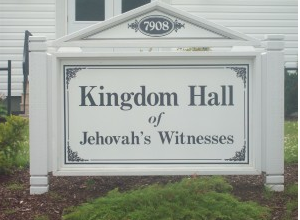 and is not considered to be sacred ritual; visitors to the weekly services might be surprised to find that the sermon is followed by clapping. At the weekly meetings the audience typically is well-dressed, ethnically and racially mixed. Meetings emphasize affirming and creating the bonds of community, with hugging, handshaking, and informal conversation. Jehovah’s Witnesses practice public baptism in order to symbolize official membership into the sect. Baptisms are performed at the Kingdom Hall, and after baptism the believer is considered to be an official member of the church, a “baptized publisher.”
and is not considered to be sacred ritual; visitors to the weekly services might be surprised to find that the sermon is followed by clapping. At the weekly meetings the audience typically is well-dressed, ethnically and racially mixed. Meetings emphasize affirming and creating the bonds of community, with hugging, handshaking, and informal conversation. Jehovah’s Witnesses practice public baptism in order to symbolize official membership into the sect. Baptisms are performed at the Kingdom Hall, and after baptism the believer is considered to be an official member of the church, a “baptized publisher.”
ORGANIZATION/LEADERSHIP
Charles Russell co-founded the Zion’s Watch Tower Tract Society in 1881 and was named as its president; three years later the 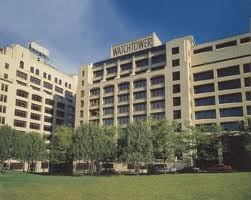 Society incorporated. In 1908, Russell moved the headquarters of the Watch Tower Society from Pittsburgh to its present location in Brooklyn, New York. The Governing Body and printing operations are located in Brooklyn. The corporate headquarters is located in Philadelphia, Pennsylvania, and there is a secondary corporate office in New York State. In the schism following Russell’s death in 1916, the Society lost a substantial proportion of its membership. Rutherford renamed the Watch Tower Society and its remaining membership as Jehovah’s Witnesses in 1931 (Holden 2002).
Society incorporated. In 1908, Russell moved the headquarters of the Watch Tower Society from Pittsburgh to its present location in Brooklyn, New York. The Governing Body and printing operations are located in Brooklyn. The corporate headquarters is located in Philadelphia, Pennsylvania, and there is a secondary corporate office in New York State. In the schism following Russell’s death in 1916, the Society lost a substantial proportion of its membership. Rutherford renamed the Watch Tower Society and its remaining membership as Jehovah’s Witnesses in 1931 (Holden 2002).
Since the presidency of Rutherford, the Jehovah’s Witnesses have been organized hierarchically, with exclusively white men in leadership. Many of the leaders of the church have little formal education. The hierarchy is headed by a President, who oversees The Governing Body of seven. The president and the governing body are all deemed to be “anointed.” The governing body remains at the church’s Brooklyn headquarters. Below that, the church is organized regionally: with traveling overseers, congregations, committees and elders, and a hierarchy of publishers determined by the number of hours that they devote to spreading the word. The base of the pyramid is made up of the “publishers,” those who go door to door spreading the word, and distributing and selling materials. No Jehovah’s Witnesses receive any compensation for their preaching; only foreign missionaries may sometimes receive a meager subsistence stipend.
Officially, to be a member of the Jehovah’s Witnesses is to be at least a “publisher.” Those who merely attend the memorial or other services are not counted as members of the church. Publishers are ordained ministers, and they are expected, though not required, to preach. They must report their activity to an Elder twice a month, and if there door-to-door ministry is less than one hour a week, they may be deemed “inactive.” Unbaptized children may preach if they are approved, but they are not otherwise counted as members of the church. Members of the church may divorce even though the sect emphasizes family within a patriarchal family structure. Jehovah’s Witnesses practice the “shunning” of former members, which means that even family and friends within the sect will cut off all contact with a member who has left the sect.
There are over seven million Jehovah’s Witnesses in the world (Cragin and Lawson 2010; Iannacone and Stark 1995). The growth of the sect is fueled by effective proselytizing and conversion rather than internal growth. Jehovah’s Witnesses can be found on every continent. It is difficult to determine the exact size of the group, since the Witnesses themselves count only Baptized Publishers as members of the church. This number is far exceeded by the number of those who self identify as Jehovah’s Witnesses on census reports. Currently, the highest rate of growth for Jehovah’s Witnesses is in areas where the pangs of modernization are still felt, such as Latin America, Asia, and Africa. In countries like the United States, where Jehovah’s Witnesses originated, and in Europe, the population of Jehovah’s Witnesses grows at a more moderate pace.
ISSUES/CHALLENGES
New and sectarian religious groups have routinely experienced considerable opposition (Miller and Flowers 1987; Richardson 2004). Jehovah’s witnesses have faced many challenges arising from their refusal to serve in the military, to participate in the political process, to pledge allegiance to any other than Jehovah, and their active proselytizing and literature sales campaigns (Penton 2004; Sprague 1946). In the United States, beginning in the 1940s, Jehovah’s Witnesses pursued an activist litigation strategy that won them, and other religious minorities, many free exercise protections. Supreme Court rulings in a number of cases involving Jehovah’s Witnesses are landmarks of First Amendment jurisprudence (Henderson 2010).
Cantwell v. Conneticut, 310 U.S. 296 (1940), the Court incorporated the Free Exercise clause of the First Amendment to the 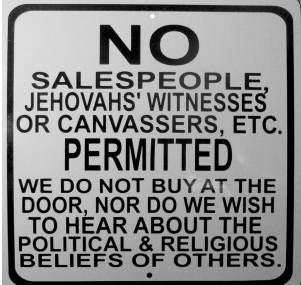 Constitution when it overturned the convictions of two Jehovah’s Witnesses who had been charged, under a local ordinance, with disturbing the peace for their door–to-door proselytizing.
Constitution when it overturned the convictions of two Jehovah’s Witnesses who had been charged, under a local ordinance, with disturbing the peace for their door–to-door proselytizing.
Chaplinsky v. New Hampshire, 315 U.S. 568 (1942), the Court upheld the arrest of a Jehovah’s Witness on the grounds that his “fighting words,” were a Constitutional exception to First Amendment free speech protections.
West Virginia State Board of Education v. Barnette, 319 U.S. 624 (1943), the Court ruled that the First Amendment protected students from being forced to salute the American flag and say the Pledge of Allegiance in school.
Watchtower Society v. Village of Stratton 536 U.S. 150 (2002), the Court ruled that it was unconstitutional to require Jehovah’s Witnesses to obtain a special license from the city and the approval of the mayor in order to go door to door to perform their ministry.
The Jehovah’s Witnesses were represented in many of these cases by Hayden Covington, a Jehovah’s Witness who eventually became the head of their corporate legal department. Covington brought 44 Jehovah’s Witness cases before the Supreme Court, and won over 80% of them. Covington was also instrumental in obtaining pardons, on the grounds of freedom of conscience for the Jehovah’s Witnesses who had been convicted of draft dodging during World War II. Covington successfully represented the Muslim boxer, Muhammad Ali, in overturning his conviction for evading the draft.
Today, in the United States, Jehovah’s Witnesses are well protected in the free exercise of their religion by the Constitution, but the same problems they faced in the U.S. they face abroad. As the church has grown into an international body, their singular obedience to Jehovah and their character as a new religion have both provoked restrictions and challenges (Peters 2000).
In France, when Jehovah’s Witnesses were deemed a suspicious “sect,” crushing fines and taxes were retroactively levied against them by the French government and their status as an exempt religious organization was revoked. In 2011, the European Court of Human rights ruled that this was an egregious violation of their human rights.
In Eritrea and Rwanda, hundreds of Jehovah’s witnesses are regularly jailed for their refusal to bear arms or participate in politics.
In India, Jehovah’s Witnesses missionaries are routinely harassed and beaten by police.
In most CIS states, the church is outlawed, and adherents are subjected to harassment, destruction of their property, and numerous other abuses.
In South Korea, nearly 1,000 Jehovah’s witnesses are in jail for refusing to enlist in the military (Henderson 2010).
REFERENCES
Holden, Andrew. 2002. Jehovah’s Witnesses Portrait of a Contemporary Religious Movement. New York: Routledge.
Barbour, Neil and Charles Taze Russell. 1877. Three Worlds and the Harvest of This World. Rochester, NY: Charles Taze Russell.
Beckford, James A. 1975. The Trumpet of Prophecy : A Sociological Study of Jehovah’s Witnesses. Oxford: Blackwell.
Bowman, Robert M. 1995. Jehovah’s Witnesses. Grand Rapids, MI: Zondervan.
Cragin, Ryan T, and Ronald Lawson. 2010. “The Secular Transition: The Worldwide Growth of Mormons, Jehovah’s Witnesses, and Seventh Day Adventists.” Sociology of Religion 71:349-73.
Harrison, Barbara Grizzuti. 1978. Visions of Glory : A History and a Memory of the Jehovah’s Witnesses. New York: Simon and Schuster.
Henderson, Jennifer Jacobs. 2010. Defending the Good News: The Jehovah’s Witnesses’ Plan to Expand the First Amendment. Spokane, WA: Marquette Books.
Iannaccone, Lawrence R, Daniel V. A. Olson, and Rodney Stark. 1995. “Religious Resources and Church Growth.” Social Forces 74:705-31.
Miller, Robert and Ronald Flowers. 1987. Toward Benevolent Neutrality: Church, State, and the Supreme Court. Waco, TX: Markham Press Fund.
Penton. M James. 2004. Jehovah’s Witnesses and the Third Reich : Sectarian Politics under Persecution. Toronto: University of Toronto Press.
Penton, M. James. 1985. Apocalypse Delayed : The Story of Jehovah’s Witnesses. Toronto: University of Toronto Press, 1985.
Peters, Shawn Francis. 2000. Judging Jehovah’s Witnesses : Religious Persecution and the Dawn of the Rights Revolution. Lawrence, KN: University Press of Kansas.
Richardson, James, ed. 2004. Regulating Religion: Case Studies from Around the Globe. New York: Kluwer Academic / Plenum.
Sprague, Theodore W. 1946. “The ‘World’ Concept among Jehovah’s Witnesses.” Harvard Theological Review 39:109-40.
Stroup, Herbert Hewitt. 1945. The Jehovah’s Witnesses. New York: Columbia University Press.
Publication Date:
15 August 2012
